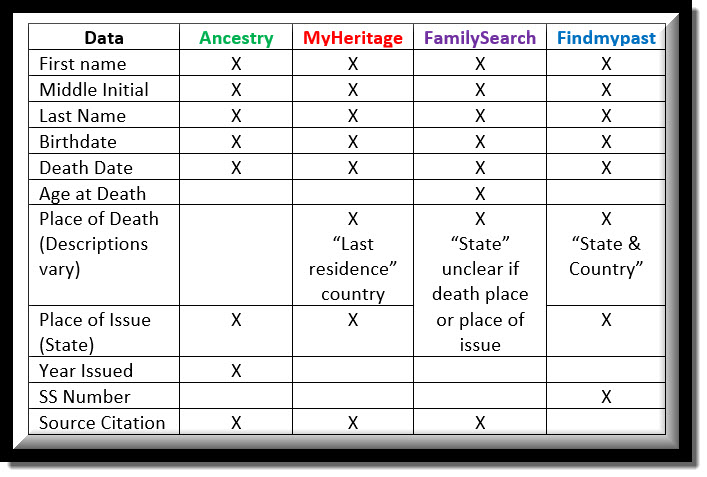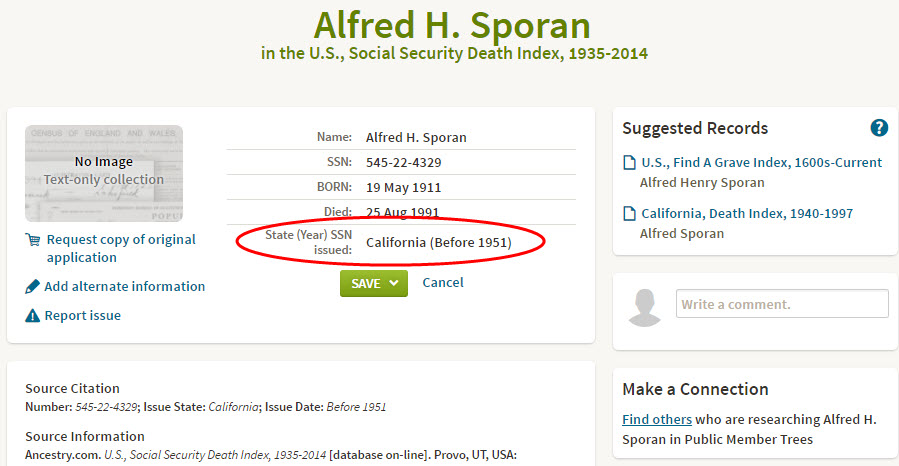by Diahan Southard | Apr 29, 2017 | 01 What's New, Genealogy Giants Websites, Records & databases |
Social Security Death Index (SSDI) search is not necessarily as straight forward as you might think. We’re going to explore what SSDI records are, their range of availability, and how they compare across the Genealogy Giants records websites.
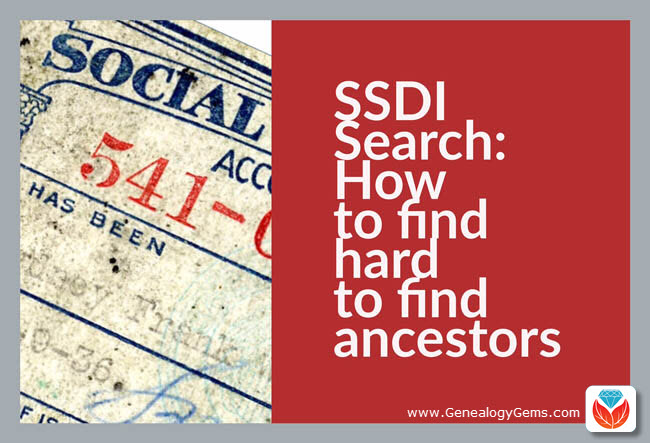
If you’ve been dabbling in genealogy research for a while, then you are very likely familiar with the Social Security Death Index, more commonly referred to as the SSDI. But even experienced researchers have questions, like the one that Marti sent me recently:
From Marti in Texas:
Hi Lisa!!
Thank you so much for all your helpful resources on your website!! I just listened to the SSDI Working Backwards podcast episode (Family History: Genealogy Made Easy episode 3) and my grandparents passed away in 2012 and 2014. Do you know when the last time the index has been updated, I cannot locate them.
Thank you so much!!
This two-fold question is a good one. While many genealogical record sets have privacy laws that dramatically restrict more recent records from being available, the SSDI is not one of them. But even if the records are available, there may still be times when we have trouble locating our relatives.
Whenever you run into a road block finding ancestors in a record collection, do what good detectives do, and go back to the beginning. In this case, let’s learn more about the collection itself.
Social Security Death Index Background
The Social Security Act was signed into law in 1935 by President Franklin Roosevelt. By 1937, more than 30 million Americans had registered. Today, the Death Master File from the Social Security Administration contains around 90 million records of deaths and they are publicly available online.
Some data goes as far back as 1937, but most of the information included in the SSDI dates from 1962. This is because the Social Security Administration began to use a computer database for processing requests for benefits in 1962. Some of the earlier records back to 1937 have not been added.
It’s important to know that the SSDI does not have a death record for everyone. It’s also very possible that you may occasionally find an error here and there if something was reported incorrectly. But don’t let that stop you from tapping into this major resource! It’s a wonderful alternative source for finding people who were counted in the 1890 census (which was unfortunately mostly destroyed) because they may still appear in the SSDI. Also, those who were born before vital records registration in their home state began, may also show up. Remember, working folks just had to live past 1937 to have been possibly included. That means some people could have been born sometime in the late 1800s.
Now that we have a handle on the history of the SSDI, let’s look at who has it and how recent their records are.
Where to Find the SSDI
The Social Security Death Index (SSDI) is available on all of the ‘big 4’ genealogy records websites, which we here at Genealogy Gems refer to as the “Genealogy Giants.” The links below will take you directly to the SSDI search page for each.
- FamilySearch
(Current as of February 28, 2014)
- Ancestry
(1935-2014)
- MyHeritage
(It is not stated how current the database is, but a search for 2014 did retrieve results)
- Findmypast
(No dates or citation provided, but a search for people who died in 2014 did retrieve results)
In Marti’s case, she will want to search every single one of these websites for her ancestors. The good news is that they all appear to be up-to-date, but that doesn’t mean they are all exactly the same. The same collection of genealogy records can appear differently from site to site for a number of reasons such as accidental omissions, variations in the power of their search engine, differences between indexers and scanners, and Optical Character Recognition (OCR) inaccuracies. These may or may not affect the SSDI, but the point is that you can’t go wrong searching each one of the Genealogy Giants just in case. And since SSDI search can be conducted for free at all of the Genealogy Giants, it doesn’t cost you anything to do so.
A quick way to find all of the websites that include the SSDI is to Google SSDI genealogy. Here’s a link to the results.
SSDI Search Head-to-Head Comparison
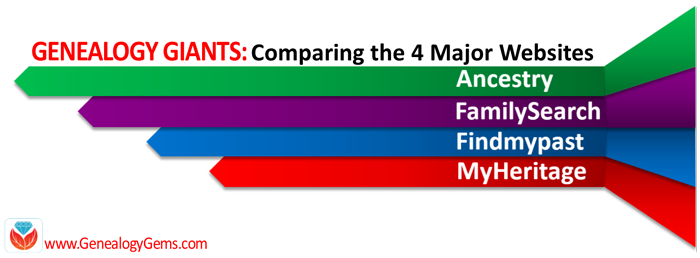 Another excellent reason to search the SSDI on multiple websites is that each website displays the information a little differently. And as you can see from the chart below, when it comes to the Genealogy Giants, there are definitely differences.
Another excellent reason to search the SSDI on multiple websites is that each website displays the information a little differently. And as you can see from the chart below, when it comes to the Genealogy Giants, there are definitely differences.
It’s interesting to note that Ancestry is the only website that provides information about the year that the Social Security number was issued. It isn’t exact, but it’s more than the others offered in my search for Alfred H. Sporan.
The differences between the 4 major websites can be sometimes subtle or quite dramatic. Understanding their strengths and weaknesses, as well as free versus subscription offerings, is key to successful research that is both efficient and cost-effective.
The quick reference guide Genealogy Giants: Comparing the 4 Major Websites is a must-have for anyone serious about getting the most out of free and paid subscriptions.
The author of this 4-page full-color cheat sheet, Sunny Morton, is Contributing Editor here at Genealogy Gems, and she’s packed this guide with everything you would ever want to know, and many things you probably didn’t know that you needed to know. You can
pick up your copy here in our store.
SSDI Search and Beyond
There is another database at Ancestry that is worth keeping your eye on. It’s called the U.S. Social Security Applications and Claims Index and it shouldn’t be missed! Currently, this covers 1936-2007, but who knows, they may update it in the future. It includes even more information. It was first released in 2015. Read more about it here at Genealogy Gems.
Gems: Share Your SSDI Search Experience!

I invite you to take a moment to share your SSDI search experience in the comments below. Have you had any surprises? Did you find a difference between the records found at different websites? We want to hear your story because we all benefit from each other’s experiences.
Disclosure: This article contains affiliate links and Genealogy Gems will be compensated if you make a purchase after clicking on these links (at no additional cost to you). Thank you for supporting Genealogy Gems!
by Sunny | Jan 12, 2018 | 01 What's New, FamilySearch, Swedish, United States
Discover your Mayflower ancestors–or more about your family history from around the world–in new and updated genealogy records online. Among them are the Welsh National Book of Remembrance for WWI and various records for Indiana, Massachusetts, Montana,...
by Lisa Cooke | Feb 18, 2016 | 01 What's New, Genealogy Gems Podcast, Libraries, Listeners & Readers
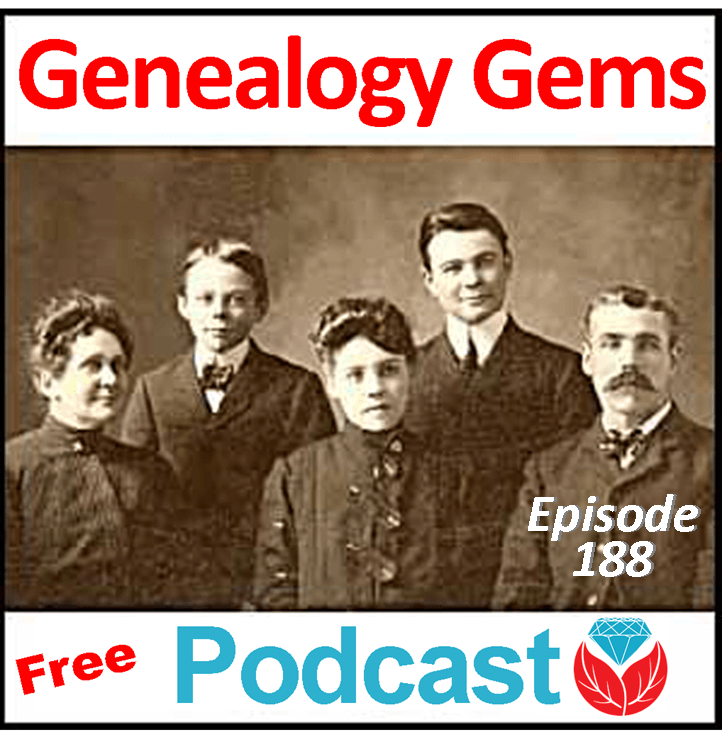 Genealogy Gems Podcast episode 188 has published. It’s packed with news, tips and inspiration that can help your family history research now. Check it out!
Genealogy Gems Podcast episode 188 has published. It’s packed with news, tips and inspiration that can help your family history research now. Check it out!
The newest episode of the free Genealogy Gems Podcast is now available. Host Lisa Louise Cooke shares her signature variety of news, inspiration, innovative strategies and tips you can use now. Highlights from the Genealogy Gems podcast episode 188 include:
- RootsTech news and resources for everyone;
- New records online for Ireland and the United States;
- Two inspiring emails from listeners who unravel family mysteries with determination, skill and Google sleuthing;
- A Genealogy Gems Book Club update with more thoughts on the featured title Orchard House: How a Neglected Garden Taught One Family to Grow
 by Tara Austen Weaver and book recommendations from RootsTech attendees;
by Tara Austen Weaver and book recommendations from RootsTech attendees;
- A critique of a recent NPR article on genetic genealogy by Your DNA Guide Diahan Southard; and
- A great conversation with Cindy Cochran and Sabrina Riley of the Lincoln-Lancaster County Genealogical Society Library at Union College in Lincoln, Nebraska.
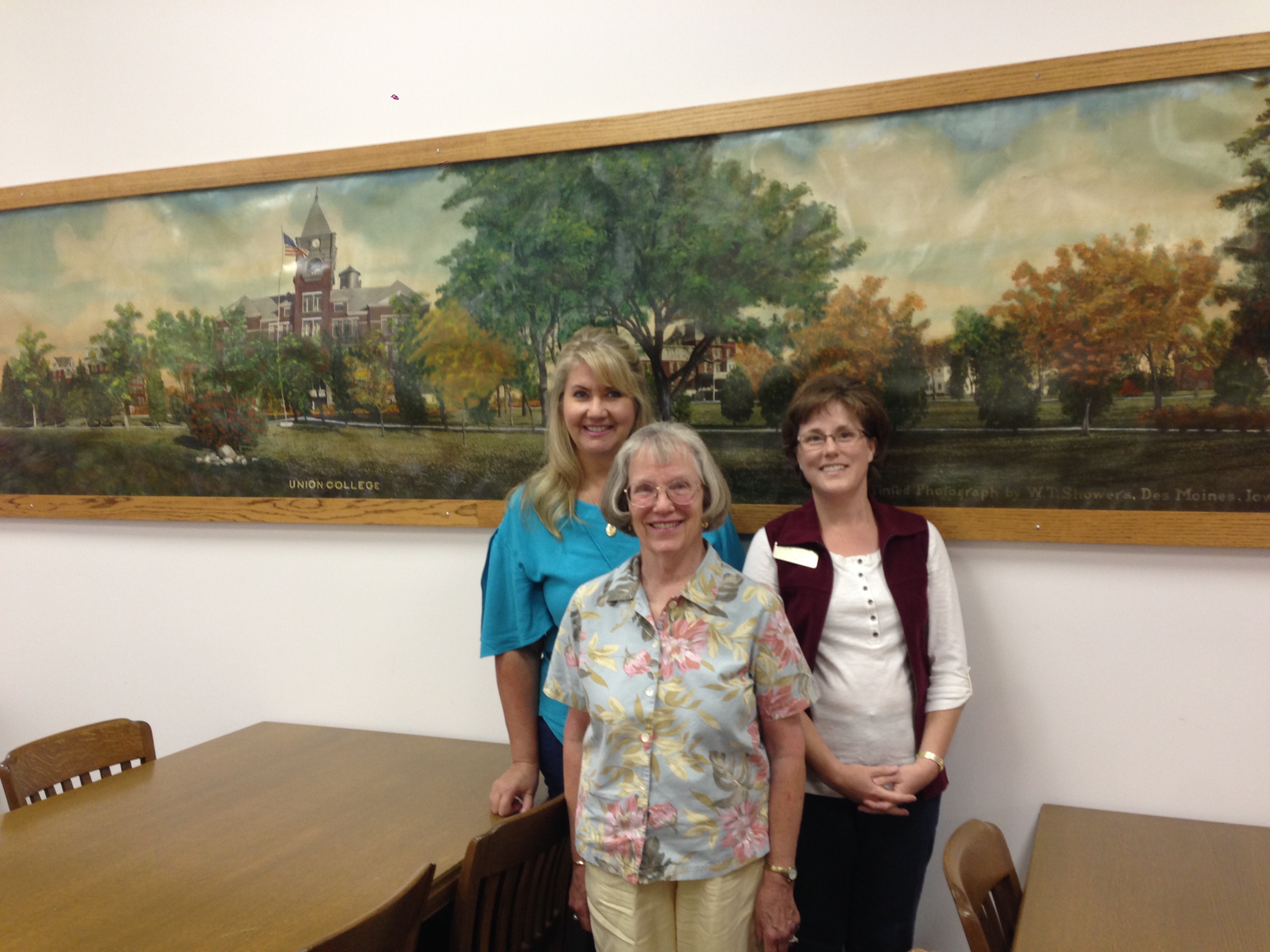
Lisa Louise Cooke with Cindy Cochran and Sabrina Riley
My favorite part of this episode for me was Lisa’s conversation with Cindy and Sabrina. It was fun to meet two interesting women who help keep their corner of the genealogy research world running smoothly. I don’t even have Nebraska roots but I appreciated the inside “look” at their genealogy collection. It reminds me what gems–human and archival–may be tucked away on college campuses that love and welcome researchers.
New to the Genealogy Gems podcast? Welcome! Click on the link above to listen; subscribe and listen in iTunes or download the Genealogy Gems app (click here to learn more about these options).
 Do you already listen to the free Genealogy Gems podcast? Will you please tell your friends and fellow “genies” about it? We especially appreciate your recommendations on your favorite social media sites–thanks for sharing this post!
Do you already listen to the free Genealogy Gems podcast? Will you please tell your friends and fellow “genies” about it? We especially appreciate your recommendations on your favorite social media sites–thanks for sharing this post!

by Lisa Cooke | Nov 19, 2013 | 01 What's New, Ancestry, Census, Family History Podcast, Findmypast, Irish, Records & databases, Research Skills, Technology
 Originally published Fall 2008
Originally published Fall 2008
Republished November 19, 2013
by Lisa Louise Cooke
[display_podcast]
Download the Show Notes for this Episode
Welcome to this step-by-step series for beginning genealogists—and more experienced ones who want to brush up or learn something new. I first ran this series in 2008. So many people have asked about it, I’m bringing it back in weekly segments.
Episode 7: Best Subscription Websites for Genealogy Research, Part 1
In our first segment, my guest is Lisa Alzo, popular genealogy lecturer and writer (now the author of nine books and online genealogy instructor at Family Tree University and the National Institute for Genealogical Studies). We talk about her reasons for researching her family history and what she’s learned in her genealogical journeys (which include international travel in Eastern Europe).
In the second half of the show, we tackle an essential topic: the best subscription sites for family history records. This is a two-part topic: in this episode I talk about the best genealogy websites that require payment to access their core content. In Episode 8, we’ll talk about the fantastic free websites that are out there.
Keep in mind that this episode was recorded a few years ago. As I mention in the show, the online records landscape is constantly changing. Here are a few updates:
- The biggest powerhouse paid subscription website is still Ancestry: it’s just bigger and better than what I originally described. As of fall 2013, they host 11 billion historical records. Member-contributed items include over 50 million family trees and 160 million uploads of photographs, stories and scanned documents. They still have a free 14-day trial membership and multiple subscription options: check out current ones here.
- WorldVitalRecords is still a great website, though it’s grown more slowly. At our republishing date, it boasts over 158 million digitized images, (including US and UK censuses); 300 million names from vital records; 75 million names from military records, over 100 million pages of newspapers dating from 1739; 1.5 million historical maps; 8000 yearbooks and over 30 million tombstone photos. WorldVitalRecords is now part of the MyHeritage.com family of websites. Click here for a free 3-day trial membership.
- Findmypast now has two web storefronts: findmypast.com (recommended for folks in the U.S.) and FindMyPast.co.uk (which specializes in British and Irish roots and records). At last glance in fall 2013, findmypast hosts over 1.5 million family history records. It offers great search options and a budget-friendly pay-per-view model or a more traditional subscription.
- RootsIreland is now home now to over 20 million Irish records.
- Genline.com for Swedish research is still online, though it’s part of Ancestry.com now. It’s home to over 20 million church record images and more.
- Scotland’s People is still your official home for online Scottish records, including an enormous collection of parish records with births and baptisms, banns and marriages and deaths and burials.
- Many other sites support specific topics in genealogy research. An example on my side of the pond is Fold3 (formerly Footnote) for American military records. This site is home to over 400 million total records from the Revolutionary War era forward. Check with others who research families from the same location or ethnic background as your family to see what sites would be perfect for you.
Links
Ancestry
Findmypast.com
Findmypast.uk.com
Fold3
WorldVitalRecords
My website mentioned in the podcast, GenealogyGems.tv, is now better known as www.genealogygems.com. The Genealogy Gems newsletter mentioned in the episode is now my blog, which you can find on my website.

 Another excellent reason to search the SSDI on multiple websites is that each website displays the information a little differently. And as you can see from the chart below, when it comes to the Genealogy Giants, there are definitely differences.
Another excellent reason to search the SSDI on multiple websites is that each website displays the information a little differently. And as you can see from the chart below, when it comes to the Genealogy Giants, there are definitely differences.